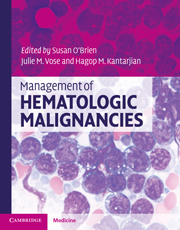Book contents
- Frontmatter
- Contents
- List of contributors
- 1 Molecular pathology of leukemia
- 2 Management of acute myeloid leukemia
- 3 Treatment of acute lymphoblastic leukemia (ALL) in adults
- 4 Chronic myeloid leukemia
- 5 Chronic lymphocytic leukemia/small lymphocytic lymphoma
- 6 Myelodysplastic syndromes (MDS)
- 7 Hairy cell leukemia
- 8 Acute promyelocytic leukemia: pathophysiology and clinical results update
- 9 Myeloproliferative neoplasms
- 10 Monoclonal gammopathy of undetermined significance, smoldering multiple myeloma, and multiple myeloma
- 11 Amyloidosis and other rare plasma cell dyscrasias
- 12 Waldenstrom's macroglobulinemia/lymphoplasmacytic lymphoma
- 13 WHO classification of lymphomas
- 14 Molecular pathology of lymphoma
- 15 International staging and response criteria for lymphomas
- 16 Treatment approach to diffuse large B-cell lymphomas
- 17 Mantle cell lymphoma
- 18 Follicular lymphomas
- 19 Hodgkin lymphoma: epidemiology, diagnosis, and treatment
- 20 Treatment approaches to MALT/marginal zone lymphoma
- 21 Peripheral T-cell lymphomas
- 22 Mycosis fungoides and Sézary syndrome
- 23 Central nervous system lymphoma
- 24 HIV-related lymphomas
- 25 Lymphoblastic lymphoma
- 26 Burkitt lymphoma
- Index
- References
26 - Burkitt lymphoma
Published online by Cambridge University Press: 10 January 2011
- Frontmatter
- Contents
- List of contributors
- 1 Molecular pathology of leukemia
- 2 Management of acute myeloid leukemia
- 3 Treatment of acute lymphoblastic leukemia (ALL) in adults
- 4 Chronic myeloid leukemia
- 5 Chronic lymphocytic leukemia/small lymphocytic lymphoma
- 6 Myelodysplastic syndromes (MDS)
- 7 Hairy cell leukemia
- 8 Acute promyelocytic leukemia: pathophysiology and clinical results update
- 9 Myeloproliferative neoplasms
- 10 Monoclonal gammopathy of undetermined significance, smoldering multiple myeloma, and multiple myeloma
- 11 Amyloidosis and other rare plasma cell dyscrasias
- 12 Waldenstrom's macroglobulinemia/lymphoplasmacytic lymphoma
- 13 WHO classification of lymphomas
- 14 Molecular pathology of lymphoma
- 15 International staging and response criteria for lymphomas
- 16 Treatment approach to diffuse large B-cell lymphomas
- 17 Mantle cell lymphoma
- 18 Follicular lymphomas
- 19 Hodgkin lymphoma: epidemiology, diagnosis, and treatment
- 20 Treatment approaches to MALT/marginal zone lymphoma
- 21 Peripheral T-cell lymphomas
- 22 Mycosis fungoides and Sézary syndrome
- 23 Central nervous system lymphoma
- 24 HIV-related lymphomas
- 25 Lymphoblastic lymphoma
- 26 Burkitt lymphoma
- Index
- References
Summary
Introduction
Burkitt lymphoma (BL) is an uncommon B-cell lymphoma characterized by high proliferation rate and cytogenetic changes related to c-Myc proto-oncogene overexpression. It encompasses a heterogeneous group of highly aggressive B-cell lymphoma. It is seen frequently in children and young adults in the endemic areas. As the result of the world epidemic of AIDS, the number of adult BL cases has increased significantly in the last few decades. In the United States, BL has an incidence of 1200 patients per year.
This lymphoma was first described by Denis Burkitt in 1958 in children in Africa. This type of endemic BL was described in children with jaw tumors with eventual spread to extranodal sites, particularly the bone marrow and leptomeninges. In the USA, BL is more commonly diagnosed in adult patients over age 40 years. According to the Surveillence, Epidemiology and End Results (SEER) registry, 59% of the BL cases in the USA are in patients over the age of 40 years.
The challenge of correctly identifying the BL in an individual patient becomes particularly critical as BL is rapidly fatal if not treated rapidly and appropriately with brief intensive chemotherapy. Initiation of the correct treatment early has yielded excellent results; however, when patients with BL were treated with regimens for diffuse large B-cell lymphoma (DLBCL), the long-term outcomes were inferior. On the other hand, the intensive therapy is not the favored choice for DLBCL, since it is associated with higher toxicity.
- Type
- Chapter
- Information
- Management of Hematologic Malignancies , pp. 494 - 502Publisher: Cambridge University PressPrint publication year: 2010



